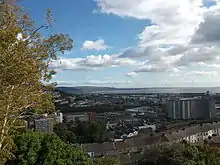Mayhill
Mayhill is a district of Swansea, Wales, at the top of a steep hill of the same name just north west of the city centre, partly separated from Townhill to the west.
History
Mayhill was one the first areas of Swansea to benefit from the development of council housing in the early years of the 20th century when Swansea Borough Council sought to address the issue of the poor quality of the housing stock available to working class families. One of the first projects it authorised was the Baptist Well Estate, a scheme for 142 terraced houses which included Shelley and Byron Crescents (subsequently renamed High View and Long Ridge respectively), built in 1910 on the lower slopes of Mayhill. Influenced by the housing reform movement of the time, the Council went on to organise an exhibition in 1910 of newly designed Garden city style houses which became allocated to a site in Mayhill. Twenty-nine houses were built by 1914, eight by the Council's own Direct Administration unit (including 2 to 12 Islwyn Road). The Council's plans to expand the Mayhill Garden City development had to be deferred until the mid-1920s due to the outbreak of the First World War.[1]
Before the Mayhill Garden City development the area was occupied by farmland. At the eastern end of Long Ridge is a Jewish burial ground which dates from 1768 and the site of Baptist Well, part of a water course which supplied the town before reservoir storage was developed.[2]

Swansea Blitz
Over a period of three days from 19 February 1941 during the Second World War, successive German bombing raids caused devastation in Swansea in what became known as the Swansea Blitz. During one such raid on 20 February 1941, fourteen homes were destroyed and twenty-four residents and another six firemen and civil defence volunteers perished at Teilo Crescent, Mayhill. A memorial plaque in Teilo Crescent commemorates the lost lives and those of others from Mayhill and the neighbouring Townhill district killed during the war.[3]
Mayhill district

Mayhill is geographically divided into Mayhill South (Mayhill Garden City) and Mayhill North (Mountain View) by Townhill Road. It is in the Townhill ward.
The south side of Mayhill overlooks the city centre, docklands and Swansea Bay. A prominent landmark on Mayhill, visible from the city centre and Hafod, is Sea View Primary School designed by the Swansea Borough architect, Ernest Morgan. The north side of Mayhill looks out towards the northern districts of Swansea and onwards towards the mountainous terrain of the Brecon Beacons.[4]
Mayhill features several park and nature reserve areas, including Bryn y Don park and a Site of Special Scientific Interest on the border of Townhill, opposite Our Lady of Lourdes Roman Catholic church. The largest open space recreational area is around Sea View Primary School and includes parkland, small wooded areas, and heathland. There are woodland areas between Waun Wen Road and Townhill Road.[5]
West End F.C. play at Pryderi Park Stadium in the area.
References
- Nigel Robins (1992) Homes for Heroes: Early Twentieth-Century Council Housing in the County Borough of Swansea. Swansea: Swansea City Council pp. 1-17
- Nigel Jenkins (2008) Real Swansea. Bridgend: Seren. pp. 198-203
- The devastating night 24 friends, family and neighbours were killed on one Welsh street, Wales Online, 22 February 2021, retrieved 20 March 2023
- Nigel Jenkins (2008) Real Swansea. Bridgend: Seren. p. 203
- Nigel Jenkins (2008) Real Swansea. Bridgend: Seren. pp. 198-205